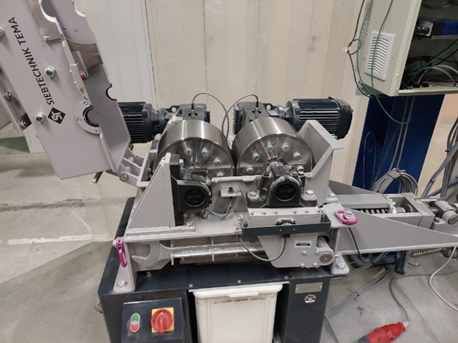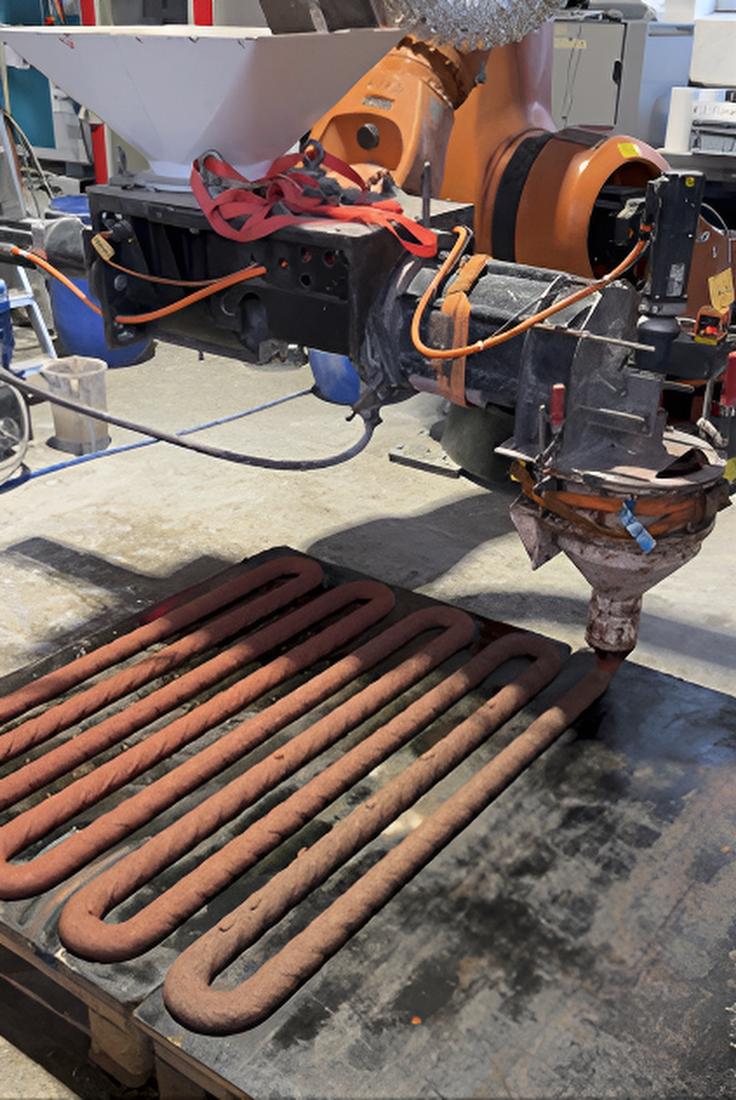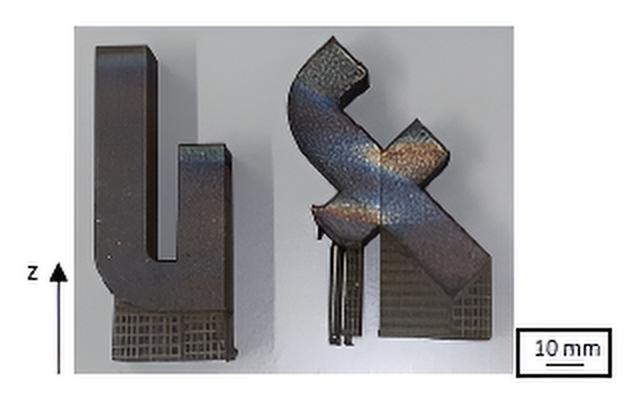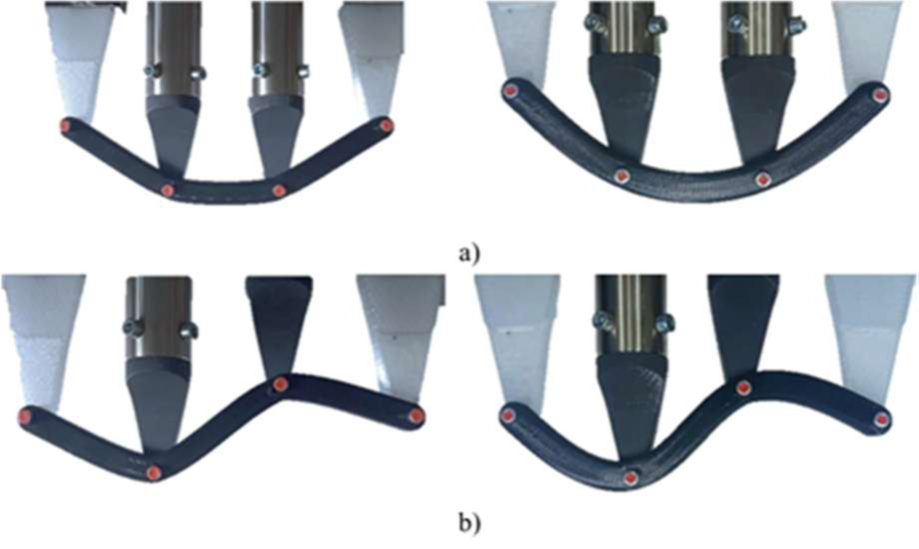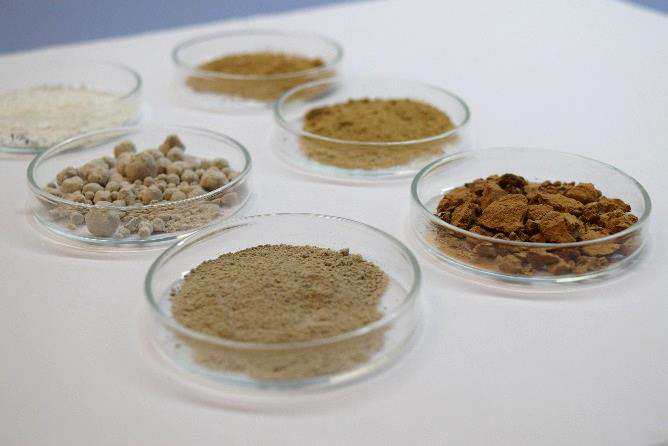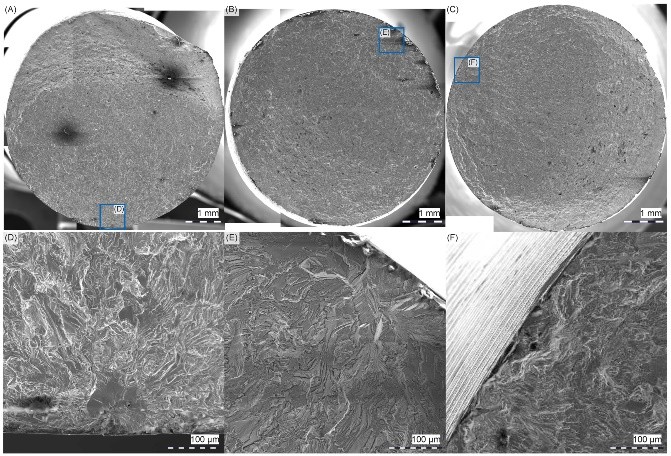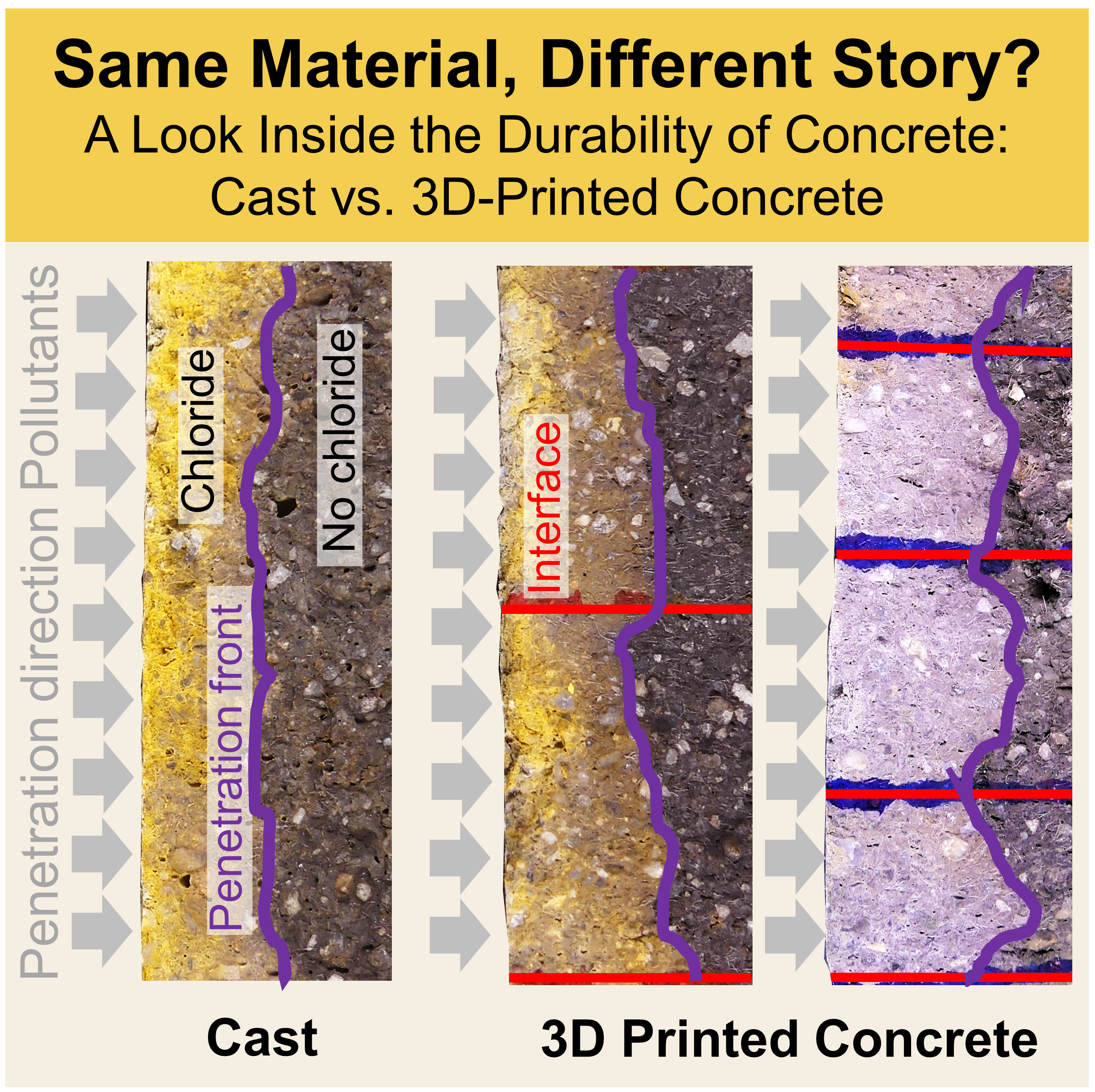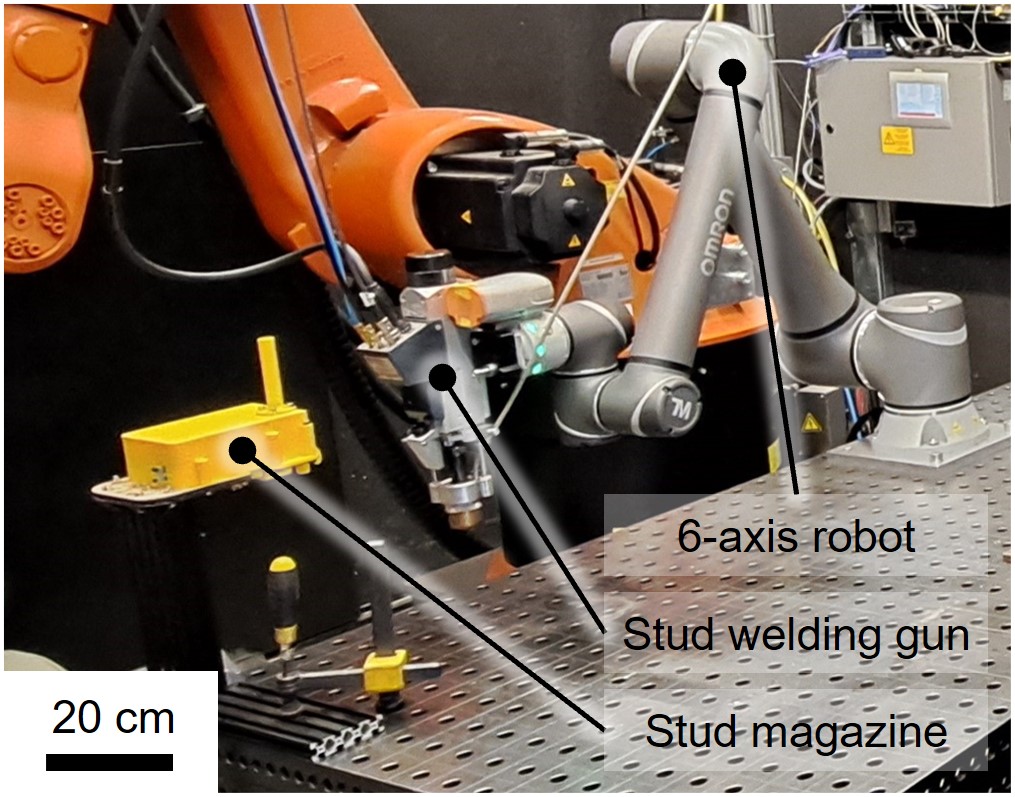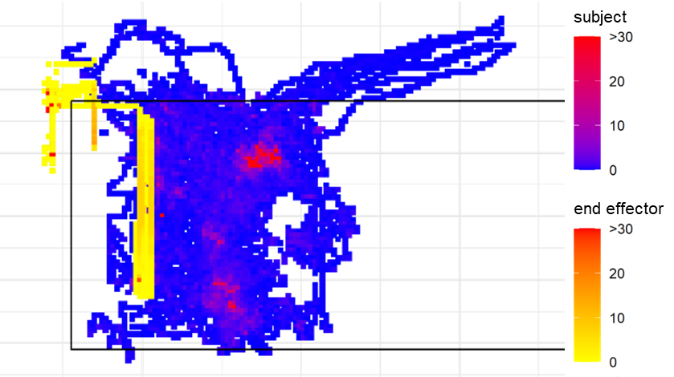Research Summary Report
Research Summary Report of A02
Category: Research Summary Report
Particle-Bed 3D Printing by Selective Cement Paste Intrusion (SPI) – Particle Surface Functionalisation, Particle Synthesis and Integration of WAAM Reinforcement [10.09.2025] Hamilton, Leigh Duncan; Doctoral Researcher, L.Hamilton@tu-braunschweig.de Zetzener, Harald; Leading researcher, H.Zetzener@tu-braunschweig.de Kwade, Arno; Project Leader, A.Kwade@tu-braunschweig.de TU Braunschweig, Institute for Particle Technology Main Goal To enable selective paste intrusion (SPI) for practical …
Research Summary Report of A03
Category: Research Summary Report
Extrusion of Near-Nozzle Mixed Concrete – Individually Graded in Density and in Rate of 3D Fibre Reinforcement [05.09.2025] Cheng, Shengbo; Doctoral Researcher, shengbo.cheng@tum.de Bos, Freek; Project Leader, freek.bos@tum.de TU Munich, Chair of Concrete and Masonry Structures (mb) Main Goal With the near nozzle mixing (NNM) approach in A03, functionally graded 3D concrete printing (3DCP) has been established as a feasible process. Building on the concept of material gradation and the development of ‘Gradation-ready extrusion system (GRES)’, continues transitions from lightweight concrete to normal concrete …
Research Summary Report of A05
Category: Research Summary Report
Integration of Individualized Prefabricated Fibre Reinforcement in Additive Manufacturing with Concrete [22.08.2025] Thiele, Philip; Doctoral Researcher, philip.thiele@tu-braunschweig.de Hühne, Christian; Project Leader, christian.huehne@tu-braunschweig.de TU Braunschweig, Institute of Mechanics and Adaptronics (IMA) The individual integration of fibre reinforcement into large additively manufactured concrete components allows new design freedom and reduces concrete consumption due to reduced concrete cover. Strategies for the integration of freely formable reinforcing strands for different AM processes are being developed in project A05. A Dynamic Winding Machine is used to prepare reinforcement strands. …
Research Summary Report of A06
Category: Research Summary Report
Laser Powder-Bed Fusion (LPBF) of Steel Elements for Construction – Basics of Design and Mechanical Resilience [08.08.2025] Suchowerchov, Julia; Doctoral Researcher, julia.suchowerchov@tum.de Technical University of Munich, Institute for Machine Tools and Industrial Management Blankenhagen, Jakob; Doctoral Researcher, jakob.blankenhagen@tum.de Technical University of Munich, Chair of Metal Structures Summary The project A06 aims to develop a methodology for producing safe and functional structural steel elements for the construction industry using laser powder bed fusion (LPBF). The LPBF steel Printdur HSA® will be qualified by using and transferring methodologies …
Research Summary Report of A04
Category: Research Summary Report
Integrated Additive Manufacturing Processes for Reinforced Shotcrete 3D Printing (SC3DP) Elements with Precise Surface Quality [11.07.2025] Megnet, Manuel1; Doctoral Researcher, m.megnet@tu-braunschweig.de Dröder, Klaus1; Project leader, k.droeder@tu-braunschweig.de TU Braunschweig, Institute of Machine Tools and Production Technology (IWF) Main Goal: Project A04 aims to investigate innovative Additive Manufacturing (AM) processes based on Shotcrete 3D Printing (SC3DP) for the production of material-efficient, force-optimised, reinforced, loadbearing concrete components with a precise surface quality and geometrical precision. The goal is to enable the production of large-scale concrete elements with …
Research Summary Report of A07
Category: Research Summary Report
Wire and Arc Additive Manufacturing (WAAM) of Complex Individualized Steel Components [04.07.2025] M. Sc. Marc Müggenburg Researcher, marc.mueggenburg@tu-braunschweig.de Dr.-Ing. Julian Unglaub Project leader, j.unglaub@tu-braunschweig.de Technical University of Braunschweig, Institute of Steel Structures A07 focuses on developing load-specific, individual high-strength low-alloy steel DED-Arc components, understanding strengthening solutions for existing structures and designing various manufacturing strategies. The specific challenges of adaptive design and adaptive manufacturing of different scale components will be addressed and a digital twin including data from the design and manufacturing process, surface geometry and component performance will …
Research Summary Report of C06
Category: Research Summary Report
Integration of Additive Manufacturing in the Construction Process [13.06.2025] M. Sc. Karam Mawas Researcher, k.mawas@tu-braunschweig.de M. Sc. Mohammad Savadkouhi Researcher, mohammad.savadkouhi-aghamolki@tu-braunschweig.de Dr.-Ing. Mehdi Maboudi Researcher, m.maboudi@tu-braunschweig.de Prof. Dr.-Ing. Markus Gerke Project leader, m.gerke@tu-braunschweig.de Technical University of Braunschweig, Institute of Geodesy and Photogrammetry (IGP) Quality control plays a pivotal role in enabling the seamless integration of components into objects, and …
Research Summary Report of A10
Category: Research Summary Report
Earth Additive Manufacturing (EAM) – Material and Process Combinations for AM with Earth-based Materials [25.06.2025] B. Sc. Sofia Tsiotou Researcher, sofia.tsiotou@tum.de Prof. Dr. (PhD) Alisa Machner Project leader, alisa.machner@tum.de Technical University of Munich, TUM School of Engineering and Design, Professorship for Mineral Construction Materials Project A10 aims to design and investigate two novel processes for Earth Additive Manufacturing (EAM), namely, Sprayed Earth Additive Manufacturing (SEAM) as a deposition-based EAM process, and Intrusion Earth Additive Manufacturing (IEAM) as a particle-bed-based EAM process. Alongside the investigations on the two processes, earthen binder mixtures will be evaluated from a material’s perspective …
Research Summary Report of C04
Category: Research Summary Report
Particle-Bed 3D Printing by Selective Cement Activation (SCA) – Sustainability, process enhancement and material models [02.05.2025] M. Sc. Chao Li Researcher, chao1.li@tum.de Prof. Dr.-Ing. Frank Petzold Project leader, petzold@tum.de Technical University of Munich, TUM School of Engineering and Design, Chair of Architectural Informatics Project C04-WP1 aims to conceive a design decision support system (DDSS) to integrate AM technologies in the early design phase. Project C04 has formalized a ontology-based knowledge base, enabling analysis of AM for building design regarding geometric and functional conformity. The DDSS will be strengthened by implementing the case-based reasoning (CBR) method to integrate AM experts’ know-how, experience, and practical examples into the architectural design process. Summary Recent construction projects …
Research Summary Report of A01
Category: Research Summary Report
Particle-Bed 3D Printing by Selective Cement Activation (SCA) – Sustainability, process enhancement and material models [09.05.2025] M. Sc. Niklas Meier Researcher, niklas.meier@tu-braunschweig.de M. Sc. Harald Zetzener Researcher, h.zetzener@tu-braunschweig.de Prof. Dr.-Ing. Arno Kwade Project leader, a.kwade@tu-braunschweig.de Technical University of Braunschweig, Institute for particle technology The fundamental goal of project A01 is to understand material process interactions in particle-bed 3D printing by Selective Cement Activation (SCA). In SCA, a particle-bed consisting of fine aggregates and cement is applied layerwise. In between the layerwise application, a liquid is applied selectively on the upper layer of the particle-bed. Thereby, the cement hydration reaction is induced locally, and the particle-bed hardens at the desired …
Research Summary Report of A06
Category: Research Summary Report
Laser Powder-Bed Fusion (LPBF) of Steel Elements for Construction – Basics of Design and Mechanical Resilience. [15.02.2025] M. Sc. Jakob Blankenhagen Researcher, jakob.blankenhagen@tum.de Dr.-Ing. Christina Radlbeck Project leader, c.radlbeck@tum.de Technical University of Munich, TUM School of Engineering and Design, Chair of Metal Structures The project A06 aims to develop a methodology for producing safe and functional structural steel elements for construction using laser powder-bed fusion (LPBF). The LPBF steel Printdur® HSA will be qualified using and transferring methodologies from material 316L which was investigated in the first funding period. The prediction of fatigue behaviour based on process monitoring data and machine learning will be explored. Lattice structures will be used to tailor …
Research Summary Report of C03
Category: Research Summary Report
Integration of Passive and Active Functions in Additively Manufactured Construction Elements [11.04.2025] M. Sc. Ahmad Nouman Researcher, ahmad.nouman@tum.de M. Sc. David Briels Researcher, david.briels@tum.de Prof. Dr.-Ing. Thomas Auer Project leader, thomas.auer@tum.de Technical University of Munich, TUM School of Engineering and Design, Chair of Building Technology and Climate Responsive Design Project C03 explores how Additive Manufacturing (AM) can create advanced building components that integrate both passive (e.g., thermal resistance, acoustics) and active functions (e.g., ventilation, thermal activation). We leverage AM’s ability to produce complex, material- and geometry-specific elements to enhance building performance, reduce carbon emissions, and improve indoor environmental quality. We …
Research Summary Report of A04
Category: Research Summary Report
Integrated Additive Manufacturing Processes for Reinforced Shotcrete 3D Printing (SC3DP) Elements with Precise Surface Quality [11.04.2025] M. Sc. Jennifer Rudolph Researcher, j.rudolph@ibmb.tu-bs.de TU Braunschweig, Institute of Building Materials and Concrete Construction and Fire Safety (iBMB) M. Sc. David Böhler Researcher, david.boehler@tum.de Prof. Dr.-Ing. Dirk Lowke Project leader, lowke@tum.de TU Munich, Department of Materials Engineering Project A04 investigates cooperative Additive Manufacturing (AM) processes based on Shotcrete 3D Printing (SC3DP). The aim of this project is to fundamentally understand the SC3DP technology to manufacture sustainable, multi-objective optimised, reinforced concrete components with geometrically precise surface quality and improved building physics by functional …
Research Summary Report of A02
Category: Research Summary Report
Particle-Bed 3D Printing by Selective Cement Paste Intrusion (SPI) – Particle Surface Functionalisation, Particle Synthesis and Integration of WAAM Reinforcement [09.04.2025] M. Sc. Felix Riegger Researcher, felix.riegger@iwb.tum.de M. Sc. Siegfried Bähr Researcher, siegfried.baehr@iwb.tum.de All: Technical University of Munich, Institute for Machine Tools and Industrial Management To enable selective paste intrusion (SPI) for practical applications, the inclusion of reinforcement is mandatory. The focus of the first funding period was set on implementing reinforcements in SPI parts by using wire arc additive manufacturing (WAAM). During the first funding period, two main challenges were identified: the need for increased ecological sustainability for the combined process of SPI+WAAM and …
Research Summary Report of C06
Category: Research Summary Report
Integration of Additive Manufacturing in the Construction Process [12.03.2025] M. Sc. Jan Thormählen Researcher, jan.thormaehlen@tu-braunschweig.de M. Sc. Gerrit Placzek Researcher, g.placzek@tu-braunschweig.de Prof. Dr.-Ing. Patrick Schwerdtner Project Leader, patrick.schwerdtner@tu-braunschweig.de Technische Universität Braunschweig (TU BS), Institut für Bauwirtschaft und Baubetrieb/Institute for Construction Engineering and Management The integration of additive manufacturing into construction requires an interdisciplinary approach. The different competences of the team – digital fabrication in architecture (Hack), geodesy and photogrammetry (Gerke) and construction management (Schwerdtner) – lead to research from diverse perspectives on the various scalar levels of construction to be viewed holistically: component, building and industry scale. Within subproject C06, the goal of …
Research Summary Report of A07
Category: Research Summary Report
Wire and Arc Additive Manufacturing (WAAM) of Complex Individualized Steel Components [10.02.2025] Martin Gabriel Altobelli Student Assistant, martin-gabriel.altobelli@mb.tu-chemnitz.de Dr. Kevin Hoefer Researcher, kevin.hoefer@mb.tu-chemnitz.de Prof. Dr.-Ing. Jonas Hensel Project Leader, jonas.hensel@mb.tu-chemnitz.de Technische Universität Chemnitz (TUC), Institute for Joining and Assembly Technology A07 focusses on advancing WAAM technology for large structures and on-site applications by addressing material interactions and incorporating manufacturing constraints through a Holistic Design Framework (HDF). A “Learning-by-Printing” approach will enhance the process via online decision-making to mitigate geometric deviations, process irregularities, and heat accumulation. Additionally, research on buckling behaviour will investigate geometric imperfections, load-deformation, load-bearing cross sections, and ductility. The development …
Research Summary Report of A10
Category: Research Summary Report
Earth Additive Manufacturing (EAM) – Material and Process Combinations for AM with Earth-based Materials [06.02.2025] M. Sc. Hannes Eichler Researcher, hannes.eichler@tu-braunschweig.de M. Sc. Diana Zavaleta Researcher, diana.zavaleta@tu-braunschweig.de Prof. Dr. Harald Kloft Project Leader, h.kloft@tu-braunschweig.de Technische Universität Braunschweig (TUBS), Institute of Structural Design (ITE) The main goal of the A10 project is to develop and investigate two innovative Earth Additive Manufacturing (EAM) techniques: Sprayed Earth Additive Manufacturing (SEAM), a deposition-based process (PL Kloft), and Intrusion Earth Additive Manufacturing (IEAM), a particle-bed-based process (PL Dörfler). The study focuses on characterizing …
Research Summary Report of C02
Category: Research Summary Report
3D Structural Puzzle – Numerical Multi Scale Shape and Topology Optimisation Methods to Additively Manufacture Optimal Structures from Optimised Pieces [06.02.2025] M. Sc. Christiane Richter Researcher, christiane.richter@tum.de Prof. Dr. Pierluigi D’Acunto Project Leader, pierluigi.dacunto@tum.de Technische Universität München (TUM), Professorship of Structural Design (SD) Current building practices often adopt a sequential design approach, where architectural, structural, and fabrication aspects are addressed independently, resulting in excessive material consumption. The CO2 project aims to establish a Holistic Design Framework (HDF) integrating the above-mentioned aspects. Within this framework, additive manufacturing facilitates structural optimization by enabling the production of bespoke geometries for an effective use …
Research Summary Report of C01
Category: Research Summary Report
Bridging Scales – From Geometric Part Details to Construction Elements [06.02.2025] M. Sc. Matti Christmann Researcher, matti.christmann@uni-weimar.de Prof. Dr.-Ing. Stefan Kollmannsberger Project Leader, stefan.kollmannsberger@uni-weimar.de Bauhaus-Universität Weimar (BUW), Professur Data Engineering im Bauwesen (DEiB) Digital models for Additive Manufacturing (AM) must consider many different geometric scales. The scales range from micrometers up to tens of meters for metal- or concrete-based processes and mutually influence each other. Project C01 aims to develop consistent geometric and computational descriptions for the relevant AM products on all these scales. As-built structures naturally deviate from as-designed structures in geometry, topology, and material properties especially in AM. The consequences of such deviations upon the structural behavior …
Research Summary Report of B04
Category: Research Summary Report
Process Control and Adaptive Path Planning for Additive Manufacturing Processes Based on Industrial Robots with an Extended Degree of Freedom [06.02.2025] Prof. Dr.-Ing. Annika Raatz Project Leader, raatz@match.uni-hannover.de M. Sc. Lukas Lachmayer Researcher, lachmayer@match.uni-hannover.de M. Sc. Hauke Heeren Researcher, heeren@match.uni-hannover.de Leibniz Universität Hannover (LUH), Institute of Assembly Technology and Robotics The research of project B04 is dedicated to extending the current state-of-the-art path planning and process control algorithms for concrete-based additive manufacturing. The objective is to enable reproducible production of multi-material components utilizing mobile robot systems in motion, known as …

